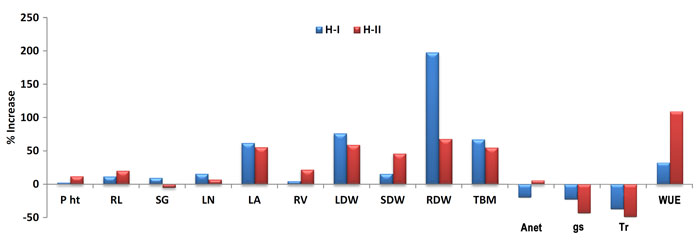The Growth Response of Maize to CO2 across Two Generations
Khan, I., Vanaja, M., Sathish, P. and Vagheera, P. 2020. Impact of elevated CO2 on two successive generations of CO2 responsive maize genotype. Climate Dynamics 44: 3469-3479.
Introducing their intriguing paper Khan et al. (2020) write that “experiments have proved that elevated CO2 brings about various physiological and growth changes in plants.” However, they write it is “still unclear whether these changes are inherited or if these responses change in subsequent generations,” adding “there is little information available on variations in the responses of plants in more than one generation to higher CO2 levels.” Thus, it was their objective to examine the performance of various morphological and physiological parameters of maize (Zea mays) growth of a cultivar across two generations.
The experiment was conducted at the Central Research Institute for Dryland Agriculture in Hyderabad, India. First generation (H-I) seeds of the cultivar Harsha were grown in open-top chambers under elevated CO2 (550 ppm) in 2016. Seeds from the harvest of these plants, as the second generation (H-II), were then sown in 2017 under both ambient (~400 ppm) and elevated (550 ppm) CO2 levels) along with fresh H-I seeds. At the vegetative stage (30 days), plants in all treatments were analyzed for various growth-related parameters and harvested for dry weights in an effort to discern if there was a difference in growth response to CO2 across the two generations.
In discussing their findings Khan et al. report second generation (H-II) plants “showed improved performance under elevated CO2 for [most] morphological and physiological parameters” (see Figure 1), adding “the H-II plants were more vigorous even under ambient CO2 condition as compared to H-I plants.” For example, net photosynthesis declined by 20% due to elevated CO2 in the H-I treatment, yet in the second generation, plants experienced a positive 6% increase. Thus, despite experiencing no positive response in net photosynthesis in the first generation, in the second generation this trend was completely reversed.
Two other important differences were noted in stomatal conductance and transpiration measurements, which were considerably lower in the H-II treatment and which resulted in much higher CO2-induced increases in plant water use efficiency in the second generation (110%) than in the first generation (33%) of CO2 exposure. Consequently, in light of this and other findings reported in their study, the four Indian researchers conclude “the data of our study clearly indicated that the advantage of elevated CO2 was higher in second-generation maize plants for all the physiological parameters,” adding “these physiological changes will certainly increase the sustainability of the crop even in moisture stress conditions.”
And thus it might well be inferred that the many benefits of atmospheric CO2 enrichment witnessed in thousands of experiments conducted on first generation crops may well vastly underestimate the true impact of this benevolent gas, which impact appears to increase across generations.

Figure 1. Percent increase (relative to ambient) in various morphological, biomass and physiological parameters of maize plants grown for one (H-I) or two (H-II) generations under elevated CO2 (+150 ppm) for 30 days in open-top chambers. P ht = plant height, RL = root length, SG = ste, girth, LN = leaf number, LA = leaf area, RV = root volume, LDW = leaf dry weight, SDW = stem dry weight, RDW = root dry weight, TBM = total biomass dry weight, Anet = photosynthetic rate, gs = stomatal conductance, Tr = transpiration rate and WUE = water use efficiency. Adapted from Khan et al. (2020).
This article appeared on the CO2 Science website at http://www.co2science.org/articles/V23/nov/a7.php
]]>